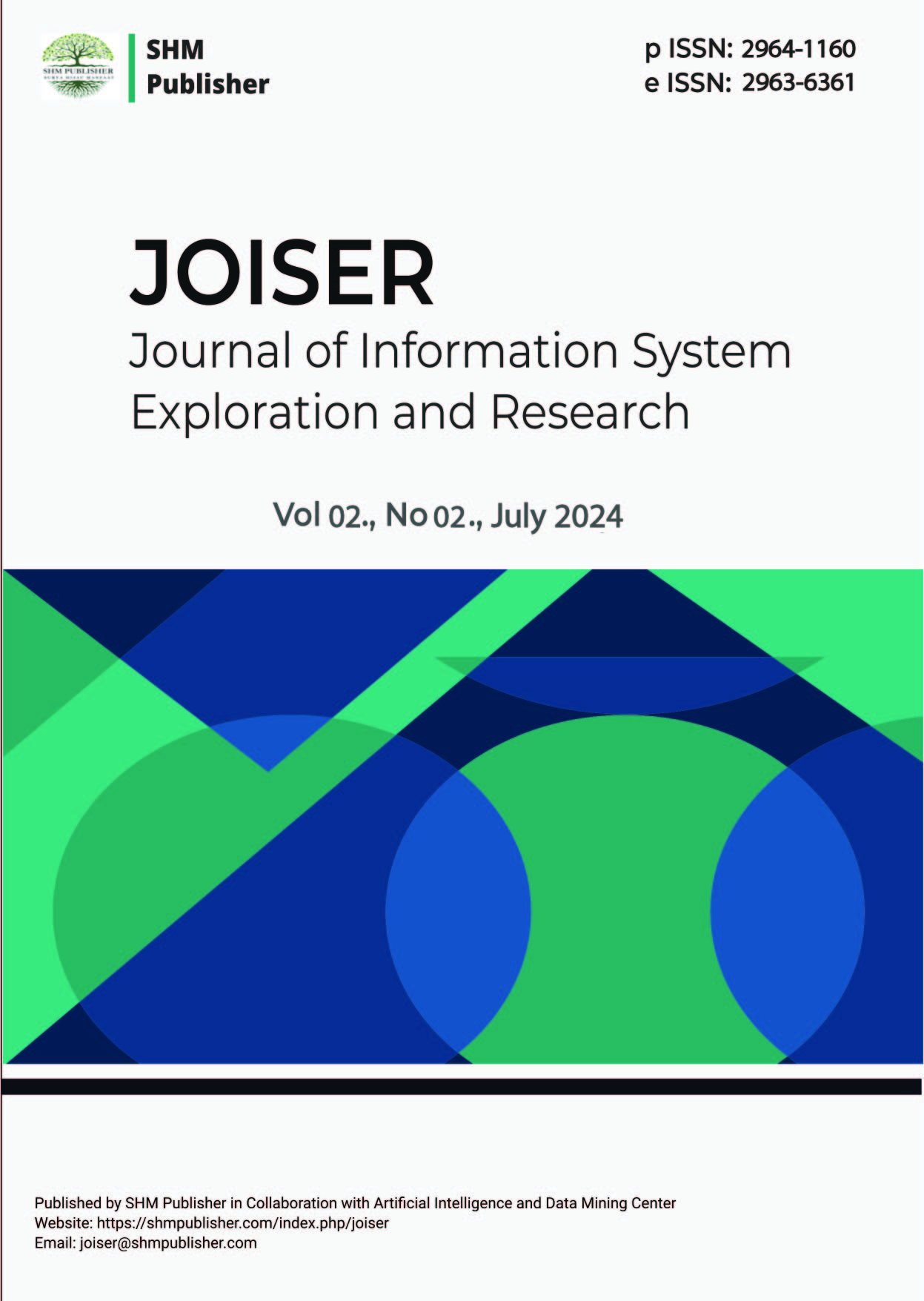The Influence of Determining the K-Value on Improving the Diabetes Classification Model using the K-NN Algorithm
Main Article Content
Abstract
Diabetes mellitus is still an important health problem globally, so it requires an efficient classification model to help determine a patient's diagnosis. This study aims to determine the K-value on the accuracy performance of the diabetes classification model using the K-Nearest Neighbors (K-NN) algorithm. This research utilizes a simulated dataset generated through interaction with ChatGPT, we investigate various K-values in the K-NN model and assess its accuracy using a confusion matrix. Based on experiments, we found that the K-NN classification model with a K=6 obtained an optimal accuracy of 97.62%. Thus, our findings highlight the important role of selecting optimal K-values in improving the performance of diabetes classification models.
Article Details

This work is licensed under a Creative Commons Attribution-ShareAlike 4.0 International License.
References
M. Dwivedi and A. R. Pandey, “Diabetes mellitus and its treatment: an overview,” J Adv Pharmacol, vol. 1, no. 1, pp. 48–58, 2020.
O. F. Offu, “A Systematic Review of the Prevalence and Treatment of Type 2 Diabetes in Nigeria.”.
R. A. Afaya, “Self-management of diabetes among type 2 diabetes mellitus patients attending diabetes clinics in selected hospitals in the Tamale Metropolis, Northern Region, Ghana.,” 2021.
O. P. Olatidoye, “Diabetic Care Center and Nutrition/Dietetics in Nigeria,” in Medical Entrepreneurship, Springer, 2023, pp. 287–310.
A. D. Susanto and N. A. Kusumastuti, “Pendidikan Kesehatan Diabetes Melitus Di Ruangan Mahoni Rumah Sakit Umum Daerah Pakuhaji,” Gudang Jurnal Pengabdian Masyarakat, vol. 2, no. 1, pp. 81–86, 2024.
G. Sanhaji, A. Febrianti, and H. Hidayat, “Aplikasi DIATECT Untuk Prediksi Penyakit Diabetes Menggunakan SVM Berbasis Web,” Jurnal Tekno Kompak, vol. 18, no. 1, pp. 150–163, 2024.
G. Obaido et al., “An interpretable machine learning approach for hepatitis b diagnosis,” Applied sciences, vol. 12, no. 21, p. 11127, 2022.
C. Azad, B. Bhushan, R. Sharma, A. Shankar, K. K. Singh, and A. Khamparia, “Prediction model using SMOTE, genetic algorithm and decision tree (PMSGD) for classification of diabetes mellitus,” Multimed Syst, pp. 1–19, 2022.
S. Peerbasha, Y. M. Iqbal, K. P. Praveen, M. M. Surputheen, and A. S. Raja, “Diabetes Prediction using Decision Tree, Random Forest, Support Vector Machine, K-Nearest Neighbors, Logistic Regression Classifiers,” JOURNAL OF ADVANCED APPLIED SCIENTIFIC RESEARCH, vol. 5, no. 4, pp. 42–54, 2023.
S. C. Gupta and N. Goel, “Enhancement of performance of K-nearest neighbors classifiers for the prediction of diabetes using feature selection method,” in 2020 IEEE 5th International Conference on Computing Communication and Automation (ICCCA), IEEE, 2020, pp. 681–686.
M. Bansal, A. Goyal, and A. Choudhary, “A comparative analysis of K-nearest neighbor, genetic, support vector machine, decision tree, and long short term memory algorithms in machine learning,” Decision Analytics Journal, vol. 3, p. 100071, 2022.
N. Gharaei, W. Ismail, C. Grosan, and R. Hendradi, “Optimizing the setting of medical interactive rehabilitation assistant platform to improve the performance of the patients: A case study,” Artif Intell Med, vol. 120, p. 102151, 2021.
N. Ali, D. Neagu, and P. Trundle, “Evaluation of k-nearest neighbour classifier performance for heterogeneous data sets,” SN Appl Sci, vol. 1, pp. 1–15, 2019.
A. A. Nababan, M. Khairi, and B. S. Harahap, “Implementation of K-Nearest Neighbors (KNN) algorithm in classification of data water quality,” Jurnal Mantik, vol. 6, no. 1, pp. 30–35, 2022.
D. Cahyanti, A. Rahmayani, and S. A. Husniar, “Analisis performa metode Knn pada Dataset pasien pengidap Kanker Payudara,” Indonesian Journal of Data and Science, vol. 1, no. 2, pp. 39–43, 2020.
O. Heranova, “Synthetic Minority Oversampling Technique pada Averaged One Dependence Estimators untuk Klasifikasi Credit Scoring,” JURNAL RESTI (Rekayasa Sistem dan Teknologi Informasi), vol. 1, no. 10, pp. 10–12, 2021.
E. Sutoyo and M. A. Fadlurrahman, “Penerapan SMOTE untuk Mengatasi Imbalance Class dalam Klasifikasi Television Advertisement Performance Rating Menggunakan Artificial Neural Network,” Jurnal Edukasi dan Penelitian Informatika (JEPIN), vol. 6, no. 3, p. 379, 2020, doi: 10.26418/jp.v6i3.42896.
B. S. Zemi, “Penerapan Algoritma Dijsktra,” no. November, 2016.
C. S. R. I. Murtono et al., “Model Klasifikasi Potensi Penyakit Diabetes Mellitus Menggunakan Metode K-Nearest Neighbor ( K-Nn ) Penyakit Diabetes Mellitus,” Skripsi, 2022.

